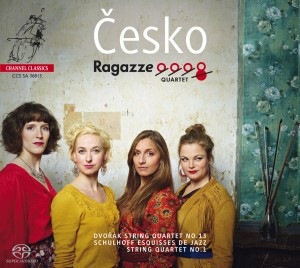 Het Ragazze Quartet bestrijkt met hun nieuwe cd het westelijk deel van Tsjechïe: de Bohemen. Op dit derde album ‘Česko‘ (dat Bohemen betekent) staan twee Tsjechische componisten centraal: Ervín Schulhoff (1894-1942) en Antonín Dvořák (1841-1904) waarvan met verve werk wordt uitgevoerd door dit Nederlands/Brits strijkkwartet.
Het Ragazze Quartet bestrijkt met hun nieuwe cd het westelijk deel van Tsjechïe: de Bohemen. Op dit derde album ‘Česko‘ (dat Bohemen betekent) staan twee Tsjechische componisten centraal: Ervín Schulhoff (1894-1942) en Antonín Dvořák (1841-1904) waarvan met verve werk wordt uitgevoerd door dit Nederlands/Brits strijkkwartet.
English version below
Eind 19de eeuw ontstaan in West-Europese landen en Rusland de Nationale Scholen. Een muzikale stroming waarin componisten muziek uit hun vaderland verwerken in hun composities. Volksmuziek, met hun karakteristieke ritmes en toonsoorten (pentatoniek en kerktoonladders), wordt door componisten geciteerd en bewerkt. Er wordt gezongen in de eigen taal, zoals in de Russische opera’s van Janacek of Moessorgsky. Volksverhalen inspireren componisten zoals de imposante Háry János Suite van Zoltan Kodaly en bovendien schrijven componisten nieuw werk dat geïnspireerd is op de volksmuziek uit hun land. Bekende componisten uit de Nationale Scholen zijn Sibelius (Finland), Grieg (Noorwegen) en De Falla (Spanje). In Tsjechoslowakije zijn dat Antonín Dvorák en de minder bekende Ervín Schulhoff. Deze twee laatsten staan centraal op de cd ‘Česko‘ van het Ragazze Quartet.
Ervín Schulhoff is een melodisch componist die put uit volkse melodieën en deze lardeert met chromatiek en diverse speeltechnieken zoals sforzato, pizzicato (tokkelen) en flagelot (spelen van boventonen). Deze technieken wisselen elkaar voortdurend af in zijn ‘Strijkkwartet No1‘, geschreven in 1924, vlak nadat hij de volksmuziek leerde kennen via het werk van Leoš Janacek. Op ‘Česko‘ vinden we een eenduidig en enerverende uitvoering waarbij het Ragazze Quartet zich opmerkelijk eensgezind toont. Fraai spelen zij de diverse klankkleuren die zich moeiteloos vleien binnen de volksmuziek signatuur die nog het best tot uiting komt in het Presto en Allegro, respectievelijk eerste en derde deel. Waar Schulhoff de melodie laat prevaleren (hoe markant deze soms ook is) is het Dvořák die zich manifesteert als lyrisch componist. Zijn muziek is gradueel en minder markant. Bovendien is het de pentatoniek (5-toons toonladder) die als een rode draad zijn werkt siert en een zekere melancholie uitstraalt. Het Ragazze Quartet neemt de tijd om het Strijkkwartet No 13 (OP113) van Dvořák breed uit te meten en gebruikt daarbij de juiste dosering waardoor het werk in diepgang wint. ‘Esquisses de Jazz’ tenslotte, van Schulhoff, is speciaal bewerkt voor het Ragazze Quartet door Leonard Evers. Dit oorspronkelijk voor piano geschreven werk vormt een link naar jazzmuziek waar Schulhoff na de Eerste Wereld Oorlog aan verslingerd raakt. In zes korte delen refereert hij aan jazz door middel van gesyncopeerde ritmiek, aangevuld met jazz harmonieën. Schulhoff wordt ontdekt door Dvořák die ervoor zorgt dat hij als tienjarige jongen kan studeren aan het Praags Conservatorium en zich kan ontwikkelen tot een volwassen componist. Schulhoff, Joods van geboorte, overleed aan de gevolgen van tuberculose in een concentratiekamp in 1942. Het Ragazze Quartet houdt zijn werk, en dat van Dvořák, levend in een doortimmerd en indrukwekkend album.
CD presentatie 5 april 2015 Bethaniënklooster Amsterdam
Recent filmpje – geen muziek uit de Bohemen maar van Stravinksy
On their new album the Ragazze Quartet plays music from the western part of the Czech Republic: Bohemia. On this third album ‘Česko‘ (which means Bohemia), we hear two Czech composers: Ervín Schulhoff (1894-1942) and Antonín Dvořák (1841-1904) performed by this Dutch / British string quartet.
Late 19th century the National Schools in Western Europe and Russia started. A way of composing in which composers arrange music from their homeland in their compositions: folk music, with their characteristic rhythms and tonalities (pentatonic and church scales). They write in their own languages, such as the Russian operas of Janacek or Mussorgsky and compose work which is inspired by folk tales like the wonderful Háry János Suite by Zoltan Kodaly. Moreover composers write new composed work inspired by the folk music of their country. Famous composers from the National Schools are Sibelius (Finland), Grieg (Norway) and De Falla (Spain). In Czechoslovakia there are Antonín Dvorák and the lesser known Ervín Schulhoff. These latter two are central on the CD ‘Česko‘ of the Ragazze Quartet.
Ervín Schulhoff is a melodic composer who uses folk melodies in his compositions and lards them with chromaticism and various playing techniques such as sforzato, pizzicato (plucking) and flagelot (playing harmonic notes). These techniques constantly change in his String Quartet No. 1, which he wrote in 1924, shortly after he became familiar with folk orientated music of Leoš Janacek. On ‘Česko‘ we find an exciting unique design in which the Ragazze Quartet shows remarkably united. Beautifully they play various sounds that effortlessly flatter within the folk signature, the best reflected in the Presto and Allegro respectively first and third part. Schulhoff is a melodic composer but Dvořák is more lyrical. His music is gradual and less marked. Moreover, he uses more the pentatonic scale (five-tone scale) which makes his music melancholic, in a way. The Ragazze Quartet easily plays Dvořák’s String Quartet No. 13 (OP113): accurate and precisely. ‘Esquisses the Jazz‘ finally, by Schulhoff, is specially arranged for Ragazze Quartet by Leonard Evers. It was originally written for piano with a link to jazz. Schulhoff got aquianted with jazz after the First World War. In six short movements we hear jazz related music through syncopated rhythms and jazz harmonies. Dvořák gave Schulhoff the oppertunity to study at the Prague Conservatory when he was only ten years old. Schulhoff, Jewish of birth, died as a result of tuberculosis in a concentration camp in 1942. The Ragazze Quartet loves the compositions of Schulhoff, and those of Dvořák’s off course and recorded their music on an impressive and breathtaking album.
- Ragazze Quartet: ‘Česko‘ (Chanel Classics/New Arts International)
© Mattie Poels.

Geen reacties